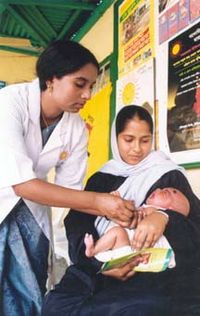
Photo from wikipedia
Seasonal malaria chemoprevention (SMC) was recommended in 2012 for young children in the Sahel during the peak malaria transmission season. Children are given a single dose of sulfadoxine/pyrimethamine combined with… Click to show full abstract
Seasonal malaria chemoprevention (SMC) was recommended in 2012 for young children in the Sahel during the peak malaria transmission season. Children are given a single dose of sulfadoxine/pyrimethamine combined with a 3-day course of amodiaquine, once a month for up to 4 months. Roll-out and scale-up of SMC has been impressive, with 12 million children receiving the intervention in 2016. There is evidence of its overall benefit in routine implementation settings, and a meta-analysis of clinical trial data showed a 75% decrease in clinical malaria compared to placebo. SMC is not free of shortcomings. Its target zone includes many hard-to-reach areas, both because of poor infrastructure and because of political instability. Treatment adherence to a 3-day course of preventive treatment has not been fully documented, and could prove challenging. As SMC is scaled up, integration into a broader, community-based paradigm which includes other preventive and curative activities may prove beneficial, both for health systems and for recipients.
Journal Title: Malaria Journal
Year Published: 2017
Link to full text (if available)
Share on Social Media: Sign Up to like & get
recommendations!